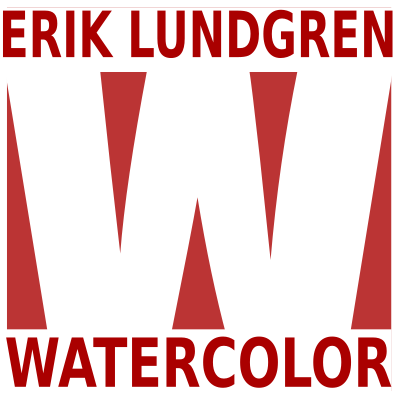Three apples in a bowl – an exercise

In this exercise, one surface is painted at a time. When a paint surface is finished, it should dry before the next one begins. You should never “improve” any part of the painting. Once you have finished painting a part, it should not be changed later. Each part is painted wet on wet. The only detail that is not painted wet on wet are the two stems on the apples.
Only three colors are used for the painting: blue, brown and yellow. I have used burnt sienna and French ultramarine and Nickel dioxin yellow.
The blue color: You need an intense blue color for this painting, cobalt, cerulean or similar does not work at all. You can choose some modern pigment like phthalo, indatren or maybe Prussian blue. But these colors dry up without a clear pattern, and both Prussian and phthalo are too green I think. But French ultramarine granulates and is warm in hue, in addition it forms a beautiful pattern and turns black with the brown. So that’s the obvious choice.
The brown color: Must be an orange-brown, it does not work with yellow-brown as sienna or yellow ocher. It also does not work with red brown like Indian red and the like, it is best with a brown that turns gray along with the blue color. I use burnt sienna because it has a beautiful orange hue. It can work with burnt umbra as well but you lose the orange hue.
The yellow color: If you use a lemon yellow color, you can get green apples together with ultramarine. I myself used a warmer yellow, namely Nickel Dioxin yellow (which is no longer manufactured, a good alternative is PY150) because it is more transparent and thus also gives better mixing results. But whichever you choose, it’s OK, the yellow color is not that important. It is only used for the apples (and a little in the background), and personally I think it works well with greyish apples.

Step 1

The background in the photo is a bit messy, a window can be seen on the right side, I have focused on this and removed all other things that you still can not distinguish properly. So paint the window by mixing colors on the paper, it does not matter which colors and how the pattern appears. But it must be beautiful! Even if it is a light surface, it should be made quite dark, it is everything else that is darker, so this is a fairly dark surface that happens to be the lightest. Do not forget to save the apples and their stems.
Step 2

Now you are going to paint what is around the window. It is done with the same technique, apply any color or color mixture and then another, let the colors mix on the paper. There should be lots of color. I have chosen to paint the window a little warmer in tone than the surrounding area. You can do differently if you want. Let the French ultramarine granulate freely. Do not forget the white (unpainted) edge between the window and the rest.
Step 3

I have chosen to make the surface brown, it is a lot of burnt sienna. Not unmixed though, a little dark gray color (blue + brown) is also painted wet on wet. So far, three separate color surfaces have been painted: the first with a yellowish tint, the second with a blue and the third with a brown color. All are painted in the same way, very wet and with different colors that mix on the paper.
Step 4

When you are going to paint the apples, it is important to paint only one and let it dry before you start on the next. Each apple is painted wet on wet, but the different apples must not flow together, so each apple must dry before you paint the next. I have painted the base color almost yellow, just a little blue in that mixture, The shadow on the apples is bluish gray. Even a little brown can be seen here and there. The white highlight on the apples is important, the brightest part of each apple is painted with just water.
Step 5

The bowl is a little harder than the rest, it should have shape and structure. Look closely at the photo. Try to paint what is dark and even darker. Save the highlights on the edges at the top of the bowl, they should be white. Do not forget the highlight on the right underside of the bowl. I have used brown and blue in different mixtures. Also paint the shadow (reflection) of the bowl on the table with the same color as you paint the bowl with. Finally, the stems are painted. As always with black details, you should not paint the entire surface. The result is too bland and heavy, so paint the stem with black almost all the way to the edge, but leave a small white edge around the black stem.












Should I use masking fluid to preserve the white ?
Absolutely not, in a picture like this it will not look good. Look artificial.